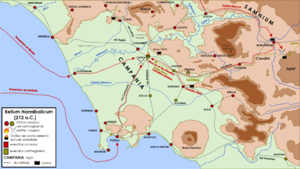This article has multiple issues. Please help improve it or discuss these issues on the talk page . (Learn how and when to remove these messages)
|
| Battle of Beneventum | |||||||
|---|---|---|---|---|---|---|---|
| Part of the Second Punic War | |||||||
 Operations in Campania during the 212 BC campaign | |||||||
| |||||||
| Belligerents | |||||||
| Roman Republic | Carthage | ||||||
| Commanders and leaders | |||||||
| Quintus Fulvius Flaccus | Hanno | ||||||
| Strength | |||||||
| 18,400 | 13,000+ | ||||||
| Casualties and losses | |||||||
| Unknown | 6,000 killed 7,000 captured | ||||||
The Battle of Beneventum was fought between Carthage and the Roman Republic in 212 BC during the Second Punic War. During this conflict, Hanno, son of Bomilcar was defeated by Quintus Fulvius Flaccus. Livy gives a short account of this battle at 25.13-14. [1]
